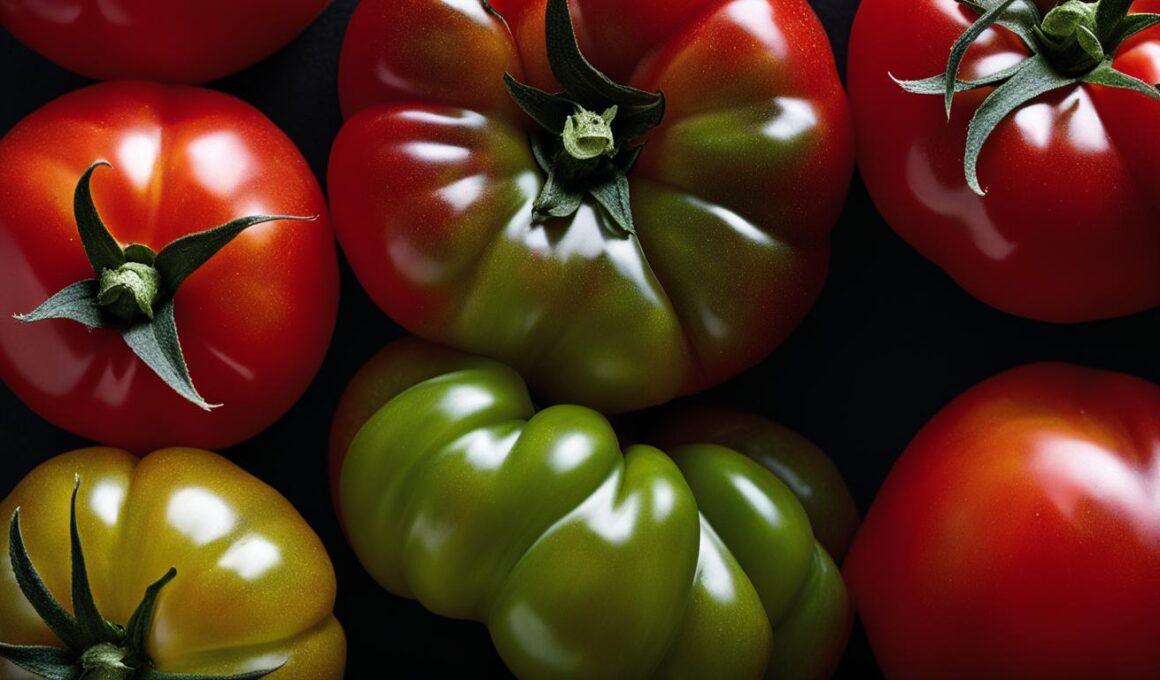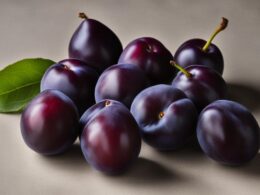Welcome to our guide on determinate and indeterminate tomatoes, where we will explore the different tomato varieties and their growth habits. Whether you are a seasoned gardener or a beginner, understanding the distinction between determinate and indeterminate tomatoes will help you make informed choices in your garden.
Tomatoes are one of the most popular and versatile fruits to grow. They come in various shapes, sizes, and flavors, making them perfect for a wide range of culinary uses. But before we delve into the specific tomato varieties, let’s first understand the difference between determinate and indeterminate tomatoes.
Determinate tomatoes are known for their bush-like growth habit. They have a predetermined height, usually reaching a maximum of 4 feet. These tomatoes also have a shorter fruit-bearing period, typically lasting around 4-5 weeks. However, they compensate for this by producing a large quantity of fruit in a shorter amount of time. If you have limited garden space or prefer a concentrated harvest, determinate tomatoes are an excellent choice.
On the other hand, indeterminate tomatoes have a vine-like growth habit. They continue to grow and produce fruit throughout the growing season until frost arrives. Indeterminate tomato plants can reach impressive heights, often requiring sturdy support, such as stakes or trellises. These tomatoes are perfect for those who enjoy a continuous harvest and have ample space in their gardens.
Now that we understand the difference between determinate and indeterminate tomatoes, let’s move on to exploring some of the best tomato varieties in each category. Whether you are looking for tomatoes for canning, sauces, or fresh consumption, we’ll provide you with valuable insights and recommendations.
Planting Guidelines for Determinate and Indeterminate Tomatoes
When it comes to planting tomatoes, whether they are determinate or indeterminate varieties, there are certain guidelines you should follow to ensure successful growth and a bountiful harvest. Here are some essential tips:
- Transplanting: Tomatoes are typically started indoors from seeds and then transplanted outdoors once they have developed a sturdy stem and several sets of leaves. It is important to wait until the danger of frost has passed and the soil has warmed up to around 60-65 degrees Fahrenheit before transplanting your seedlings. This usually occurs at the beginning of May in central Virginia.
- Soil Temperature: It is crucial to take note of the soil temperature as tomatoes thrive in warm soil. Cool temperatures can stunt their growth, so ensure the soil is sufficiently warm before transplanting. Using a soil thermometer can help you determine if the conditions are favorable.
- Spacing: Give your tomato plants enough space to grow and spread their roots. For determinate varieties, spacing them about 18-24 inches apart allows for proper airflow and prevents overcrowding. For indeterminate varieties, which tend to grow taller and require staking or trellising, a spacing of 24-36 inches is recommended.
- Watering: Tomatoes need consistent moisture to thrive but avoid overwatering, as it can lead to root rot. Water deeply once or twice a week, depending on the weather conditions and soil drainage. Aim to water at the base of the plants rather than overhead to prevent leaf diseases.
- Pruning: While determinate tomatoes don’t require much pruning, it is beneficial to remove any suckers (small shoots that emerge from leaf axils) to ensure better air circulation and focus the plant’s energy on fruit production. Indeterminate tomatoes, on the other hand, benefit from regular pruning to control their size, shape, and encourage higher yields.
By following these tomato planting guidelines, you can give your plants the best start possible and increase your chances of a successful harvest. Remember to monitor soil temperature, provide adequate spacing, water wisely, and prune as needed. Happy gardening!
The Best Determinate and Indeterminate Tomato Varieties
When it comes to growing tomatoes, choosing the right variety is key to success. Whether you prefer determinate or indeterminate tomatoes, there are several outstanding options available in the market.
For those looking for compact plants that are perfect for small spaces, determinate tomatoes are the way to go. Rutgers, Roma, Celebrity, Ace 55, and Better Bush are among the best determinate tomato varieties to consider. These tomatoes are known for their modest size and high productivity, making them ideal for canning, sauces, and jarring in large batches.
However, if you’re after exceptional flavor and versatility in the kitchen, determinate tomatoes like San Marzano Nano and Amish Paste should be on your radar. These tomatoes not only have a determinate growth habit but are also specifically bred for their outstanding taste and suitability for cooking.
On the other hand, if you have ample space and prefer tomatoes that keep producing throughout the season, indeterminate varieties are the way to go. Some popular indeterminate tomato varieties include Beefsteak, Brandywine, Cherokee Purple, Sungold, and Green Zebra. These tomatoes offer a wide range of flavors, sizes, and adaptability, allowing you to enjoy a diverse tomato harvest.
What are the Differences Between Determinate and Indeterminate Tomatoes and How are they Similar to Different Types of Pine Cones?
Determinate and indeterminate tomatoes differ in growth habit and harvest time. Similarly, varieties of pine cones vary in size, shape, and texture. While determinate tomatoes produce a set amount of fruit at once, indeterminate varieties continue to grow and produce throughout the season, much like the various types of pine cones.










